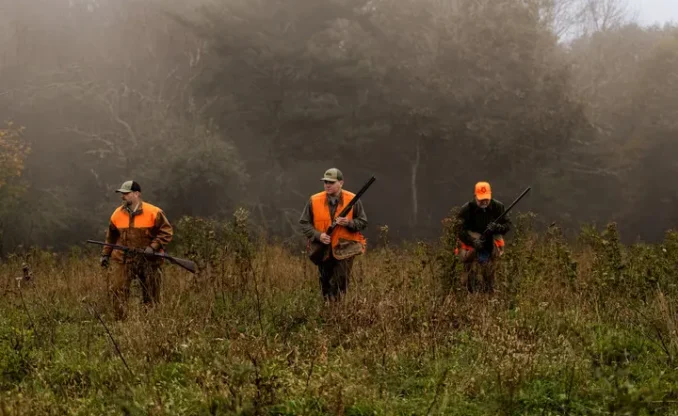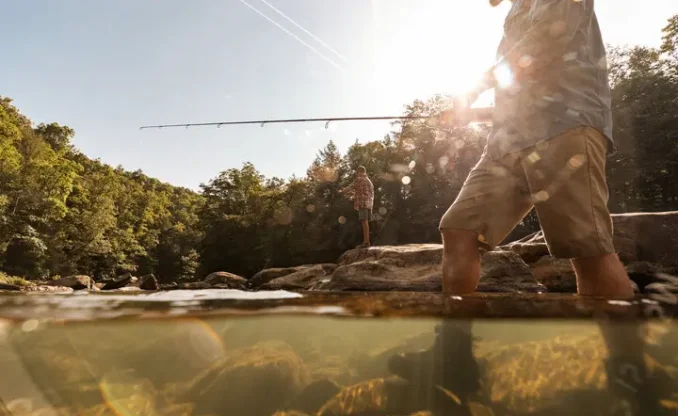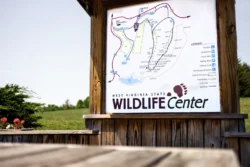Freshwater Mussels Overview
Many people when fishing, swimming, or simply dreaming away the hours watching the water flow by, never see or are even aware of a fascinating group of creatures known variously as mussels, clams, or bi-valves. In fact, North America has the richest freshwater mussel fauna in the world. Two hundred and twenty-five species have been reported in North America, with 130 reported from the Ohio River System alone. Today, in many unpolluted streams in WV, the trained observer can usually spot 20 to 30 different kinds of freshwater mussels.
Mussels live in a variety of aquatic habitats, but all require areas where the running water has a high oxygen content and supplies a rich food source of organic particles and micro- organisms (single-celled animals, bacteria and diatoms). The constant flow of water also removes waste materials that would be toxic to the mussels. The best substrate for fresh-water mussels is a combination of silt, sand, gravel or cobble with little sedimentation. Some bi-valves exist in the stiller waters of natural lakes and ponds. However, they are almost never found in impoundments. This is due to sedimentation, recirculation of waste toxic to mussels, and the high concentrations of carbon dioxide and carbonic acid which dissolves their calcerous shells.
According to Paul Parmalee in The Freshwater Mussels of Illinois, all mussels possess a soft body enclosed by two separate shells hence the common name of “bivalve.” The adult lives its entire life partly embedded in the substrate, active only in warm months. Mussels move by extending the foot out from between the shells and wedging it into bottom material. The body is then pulled along by contraction of the muscles within the foot. Mussels feed and derive oxygen by drawing in water through the in-current siphon and transferring the material to the stomach and gills, respectively. Wastes are expelled through the excurrent siphon.
The life cycle of the freshwater mussel is a complex and fascinating phenomenon. Four distinct stages occur: 1) the fertilized egg, 2) the young or glochidium in the brood sac of the female mussel, 3) the glochidium in the parasitic stage on a fish or salamander and 4) the adult, free-living stage with a shell.
Mussels are either male or female, although a few species are hermaphraditic. In many species the two sexes can be told apart by the shape of the shell. The male sex cells are released into the water and are taken into the female’s body through the in-current siphon. They are then transported to the gills where the eggs are fertilized. The gills now serve as brood pouches as well as respiratory organs. Next, the eggs develop into glochidium, possessing only partially developed organs. At this point they are discharged from the female through the excurrent siphon into the water column. If they are to survive, they must be taken into the mouth of a passing fish and attach themselves to its gills. The glochidium remain embedded for 1 to 6 weeks in the tissues of the host fish, not increasing in size, but developing adult structures. Some species of mussels parasitize only one species of fish, while others are not as particular. This parasitism usually does not harm the host fish.
At the end of the third stage the young clam dislodges itself from the fish and falls to the bottom. If a suitable substrate is encountered, the young will survive and grow to adult-hood.
Mussel shells are composed of 3 layers, the outer two being formed by glands at the edge of the mantle, and the inner, pearly iridescent or nacre layer is secreted by the entire mantle surface. The shell grows in area by the addition of material at the margin, and in thickness by successive deposits of nacre across the shell’s entire inner surface. In general, mussels that inhabit rivers or streams with a fairly fast current develop thicker shells than those found in shallow, quiet areas.
Mussels have been and are currently extremely important to man in several different ways. Native Americans used them as a food source, and shell heaps or middens may be found at many sites. These middens are important to malacologists – those who study mollusks-as they can indicate past abundance and species composition of an area. Many kinds of mussels now extinct or very rare have been found in the middens. Indians also valued the pearls found in nearly all kinds of freshwater mussels for ornamentation.
The late 1800’s witnessed the birth of the button industry which produced buttons from mussel shells. The soft bodies of the millions of clams harvested for this purpose also provided food for livestock. However, the development and refinement of plastics after World War II spelled doom for this industry.
In the 1960’s an unusual need for the shells developed that continues today as a multi-million-dollar industry mainly overseas. Pellets cut from the mussel shell, called baroques, are used to seed oysters in order to produce cultured pearls.
Freshwater mussels are an important food source for muskrat and other furbearers, waterfowl, and fish (especially the freshwater drum). Bivalves can also be used as fish bait. Besides their aesthetic appeal, mussels are very important indicators of water quality. Because freshwater mussels are filter feeders, often dependent on one species of fish for reproduction, and are basically sedentary and quite long lived, they are adversely affected by long-range water quality problems (pollution), physical barriers such as dams and locks, and changes in the abundance of fish, algae and other microorganisms.
Populations of all freshwater mussels have been drastically reduced in our streams and waterways, many to the point of extinction. West Virginia has six federally endangered mussels, the pink mucket pearly mussel (Lampsilis orbiculata), tuberculed-blossom pearly mussel (Epioblasma torulosa torulosa), James spinymussel (Canthyria collina), Fanshell (Cyprogenia stegaria), Northern riffleshell (Epioblasma torulosa rangiana) and Clubshell (Pleurobema clava). The reasons for their decline are many, and all related directly to man’s activities. Impoundments, dams, or other activities associated with these facilities create: excess sedimentation, which covers their siphons and suffocates them; physical barriers that isolate populations and separate them from host fishes; increased metals and other pollutants; and fluctuations in water flow that decreases nutrient and oxygen availability and prohibits toxic waste removal. Perhaps even more damaging because entire beds are destroyed are the activities of commercial sand and gravel dredging, navigation maintenance dredging, and barge handling associated with permanent loading and unloading facilities.
Because of their importance in the ecosystem and extent of their decline, freshwater mussels warrant further study as to distribution, relative abundance, species diversity and population stability. Some of the methods to accomplish this include handpicking in shallow water and along the shoreline (especially muskrat- middens), water scoping, snorkeling or general shallow diving, scuba diving and brailling. The latter two methods are essentially the same as used by commercial harvesters. In brailling, an individual stands at the end of a flat-bottomed “John” boat, lowering an apparatus known as a mussel brail with attached hooks. The hooks are dragged across the bottom as the boat drifts with the current. When a prong of a hook enters the partially open shells and touches or becomes embedded in the soft parts of mussels, the valves instantly clamp shut on the hook.
Studies such as these have been conducted by biologists of the WV Division of Natural Resources, Water Resources Division and the U.S. Fish and Wildlife Service in order to learn more about mussels and make recommendations on water project and policy development. This will ensure better protection of these rapidly dwindling, valuable and fascinating creatures.



